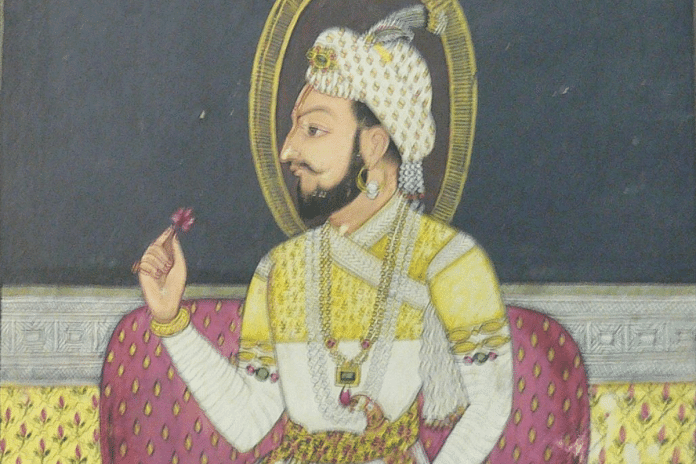History is replete with instances of fathers eclipsing their sons. Rajendra Chola’s illustrious rule paled in comparison to the legacy of his father Rajaraja the Great. Jahangir’s stature in Mughal history is diminished by that of his father Akbar. Sambhaji, Shivaji’s eldest son and successor, was no exception. Shivaji’s glorious exploits that made him the ‘greatest ruler of the Maratha empire’ overshadow the achievements of his son, who is often relegated to a footnote in popular historical narratives.
Sambhaji spent the better part of his reign protecting the Maratha empire from its enemies outside and factions within, earning him the title ‘Swarajya Rakshak’ (protector of freedom). Sambhaji made headlines after Maharashtra Chief Minister Eknath Shinde announced that Mumbai’s mammoth coastal road project will be named after him, and that his statue will be erected on the road. He was also in the news in December 2022, when Nationalist Congress Party (NCP) leader Ajit Pawar took umbrage over people calling the Maratha leader ‘Dharmaveer’ (protector of religion).
“We always refer to Chhatrapati Sambhaji Maharaj as ‘Swaraj Rakshak’…It is incorrect to call him ‘Dharmaveer’,” Pawar had said at the Maharashtra state assembly’s winter session in January 2023. He went on to say that Sambhaji “never championed the cause of any particular religion” and that his sacrifice and work were inclusive. The statements sparked protests among Bharatiya Janata Party (BJP) members in Maharashtra and stoked fears within the NCP that it could alienate Marathas.
As even current events show, Sambhaji had a lasting impact on Maratha society.
Rocky father-son relationship
Sambhaji Bhonsle was born at Purandar Fort (in present-day Pune) on 14 May 1657. His mother died when he was just two years old; his paternal grandmother Jijabai brought him up.
His first brush with political machinations was at the age of nine when he was sent to live with Raja Jai Singh I of Amber as a political hostage under the 1665 Treaty of Purandar between the Mughals and the Marathas.
Like most royal heirs, Sambhaji spent his early years on the battlefield, while learning to navigate court politics simultaneously. But his relationship with his father was rocky at best.
In his book Shivaji: India’s Great Warrior King, Vaibhav Purandare gives an insight into the father-son relationship. Sambhaji, he writes, appeared to have been extremely dissatisfied about his place in the palace. “On 13 December 1678, Sambhaji, at the age of 21, took a step that left his father stupefied. He left Satara, where he was staying at the time, for Pedgaon and joined the Mughals under Diler Khan.”
However, reportedly disillusioned by the wanton violence, he left Khan’s camp on 20 November 1679. The father and son were reunited in less than a year.
Battling enemies within
Sambhaji’s accession to the throne was a nine-month-long struggle. His chief rival was one of Shivaji’s wives, Soyarabai, who wanted to see her 10-year-old son Rajaram I on the throne. What swayed the outcome in his favour was the support of the powerful Maratha commander-in-chief Hambirraro Mohite. He was finally crowned king or Chattrapati in 1681.
And while he may have quelled internal factions—Soyarabai, Rajaram, and their supporters were placed under house arrest—his enemies were circling the young Maratha kingdom.
The Mughals were among his powerful enemies who wanted to crush the Marathas. And between 1682 and 1688, Sambhaji fought Aurangzeb’s forces on multiple fronts in the Deccan. He employed guerrilla warfare— hit-and-run tactics and ambushes—to weaken the Mughal army.
But the Mughals weren’t the only enemies. During his reign, Sambhaji waged wars on multiple fronts against the Siddis, the British, and the Portuguese. In an attempt to expand his realm, he targeted Mysore (now Mysuru), but was thwarted by the Wodeyar king Chikka Devaraja.
Sambhaji’s many strengths
Sambhaji’s governance during his reign reflected his administrative prowess and commitment to the welfare of his subjects. Despite the challenges he faced, he implemented measures to strengthen the empire and promote good governance. He installed capable administrators, formed a council of eight ministers, and put in place a strong legal system.
In addition to his administrative reforms, Sambhaji recognised the importance of cultural patronage. He encouraged arts, literature, and architecture, promoting the Marathi language and supporting the growth of the regional cultural identity.
The Battle of Wai, fought in December 1687, was a critical juncture in the conflict between the Marathas and the Mughals. His commander, Mohite, was killed. His death broke the morale of the Marathas. And in 1689, Sambhaji was captured. Some accounts claim he was betrayed by members of the Shirke clan and was apprehended by Muqarrab Khan at Sangameshwar. He, along with his advisor Kavi Kalash, were taken to Aurangzeb.
Historical records differ as to what happened following these events. British historian Dennis Kincaid, in his book Shivaji: The Grand Rebel wrote that he was tortured and killed after he refused to convert to Islam. He died on the night before Gudi Padwa on 11 March 1689.
(Edited by Anjali Thomas and Humra Laeeq)



